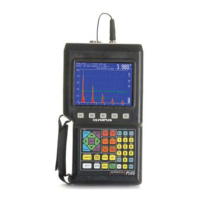Using Software Options
Part # 910-250C
107
• Thin welds (excessive indentation sometimes resulting in poor weld quality)
• Burnt welds (overheated welds resulting in brittle crystalline structure)
• Undersized welds (weld nugget is smaller in diameter than specifications allow)
• Porosity (gas bubbles present in nugget)(less common)
9.8.2.1 Echo Attenuation
As sound reflects within a potential weld nugget, its energy is absorbed into the material,
a process known as attenuation. The way sound is attenuated in a weld nugget indicates
some characteristics about that nugget. In a quality weld nugget, the metallic structure of
the metal is changed during the weld process, causing higher attenuation than in a clean,
single sheet. Ideally, the sound also travels twice the distance of a single sheet of material
(or more, depending on the number of sheets welded). This causes a higher rate of
attenuation than in a single sheet, UNWELD condition. The ring-down pattern for a
GOOD weld typically shows consistent attenuation on each successive reflection, and full
attenuation occurs faster than in the UNWELD condition. However, inconsistent or
extremely rapid attenuation can indicate a BURNT weld, or may indicate porosity within
the weld.
9.8.2.2 Echo Spacing
The spacing of multiple backwall echoes within a material indicates the thickness of the
material. The quality of a weld nugget can also be characterized by comparing the echo
spacing to a known UNWELD condition. In the case of two welded sheets, the spacing of
the ring-down echoes in a GOOD weld condition should be greater than the spacing of a
single sheet of the same material, because the sound must travel further (through both
sheets) to return an echo. When the spacing of echoes is too close together, an UNWELD
or THIN weld condition may be indicated.
9.8.2.3 Intermediate Echoes
Intermediate echoes are usually low amplitude echoes that occur between the expected,
high amplitude ring-down echoes from a weld nugget. When sound travels through a
clean and well-sized nugget, virtually all of the sonic energy passes through the weld
nugget and is returned to the transducer, creating a ring-down pattern. However, if the
nugget size is smaller than expected, some sound energy will not transmit into the weld
nugget and will instead reflect from the backwall of the first sheet and return to the
transducer. This effect is related to echo spacing, in that this partially reflected sound
creates echoes that are more frequent than the ring-down pattern of a GOOD weld
condition. However, since this is usually only a small amount of sound reflected from the
first metal sheet, these echoes are lower in amplitude than the expected ring-down echoes.
These smaller “peaks” between larger “peaks” indicate an UNDERSIZED weld nugget.
This characterization technique is the reason Spotweld transducer diameter must be
matched to nugget size for comprehensive inspections.

